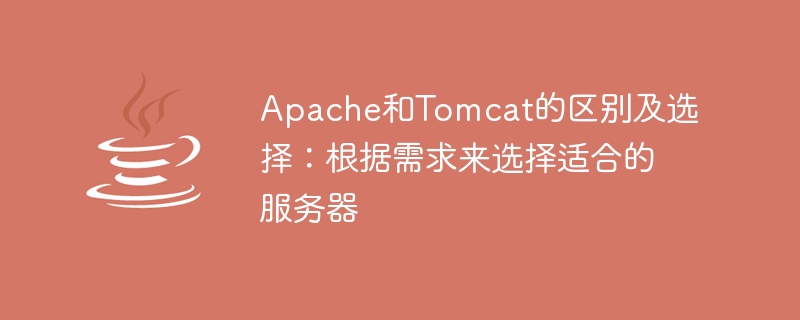

Apache and Tomcat are two common server software. They have some differences in functions and uses. This article will explore the differences between Apache and Tomcat and provide some suggestions to help readers choose a server that suits their needs.
First of all, Apache is an open source web server software that provides many feature-rich modules, such as static page serving, virtual hosting, URL rewriting, etc. Apache supports a variety of operating systems and is excellent at handling static content. It is widely used to build large websites and handle a large number of concurrent requests. Apache is a general-purpose server software that can handle various types of requests, including HTML, CSS, JavaScript, images, videos, etc.
Tomcat is an open source Java Servlet container and the engine of Java Server Pages (JSP). Tomcat is mainly used to process dynamic content. It supports Java Servlet and JSP specifications, and provides powerful Java Web development capabilities. Tomcat can run independently or in conjunction with Apache to achieve higher performance and flexibility through Apache's reverse proxy module.
The choice of Apache and Tomcat depends on the needs of the project. If the project mainly needs to provide static content and does not require Java development capabilities, then using Apache is sufficient. Apache is relatively simple to configure, has stable performance, and has extensive support and documentation.
If the project needs to handle dynamic content and relies on Java development capabilities, you can choose to use Tomcat. Tomcat provides rich support and functions for Java development, making it easy to develop and deploy Java Web applications. In addition, Tomcat also supports some advanced functions, such as session management, security authentication, remote deployment, etc.
In addition to functional differences, Apache and Tomcat also have some differences in performance and scalability. Since Apache is designed to handle concurrent requests and static content, it performs better in terms of performance. Tomcat is more powerful in handling dynamic content and Java programs, but there may be a certain performance loss in the case of large traffic. Therefore, when choosing a server, you need to weigh performance and functionality based on your project's specific needs.
In addition, if the project needs to handle both static and dynamic content, you can also choose to use Apache and Tomcat together. Through Apache's reverse proxy module, static requests can be handed over to Apache for processing and dynamic requests can be forwarded to Tomcat. This application architecture improves performance and flexibility, and enables load balancing and failover.
To sum up, Apache and Tomcat are two common server softwares. They have some differences in functions, performance and uses. According to the needs of the project, we can choose the server that suits us. For projects that mainly provide static content, you can choose Apache; for projects that need to handle dynamic content and Java development, you can choose Tomcat; at the same time, you can also use Apache and Tomcat together to obtain better performance and flexibility. When choosing a server, we should weigh various factors based on project needs and choose the most suitable server.
The above is the detailed content of How to choose the right server based on your needs: Compare the differences between Apache and Tomcat. For more information, please follow other related articles on the PHP Chinese website!
 How to set transparency of html font color
How to set transparency of html font color
 mstsc remote connection failed
mstsc remote connection failed
 Bitcoin buying and selling process on Huobi.com
Bitcoin buying and selling process on Huobi.com
 What are the advantages of SpringBoot framework?
What are the advantages of SpringBoot framework?
 How to enable TFTP server
How to enable TFTP server
 Java-based audio processing methods and practices
Java-based audio processing methods and practices
 What is bak file
What is bak file
 How to buy and sell Bitcoin in the country
How to buy and sell Bitcoin in the country




